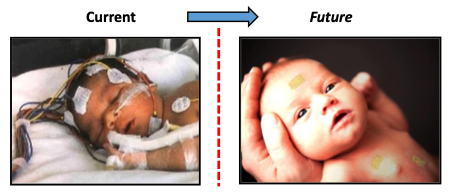Alina Rwei
Ever since she experienced how chronic kidney disease impacted the life of her grandmother, Alina Rwei wants to develop medical-technological innovations that impact patient’s lives – preferably until long after she is active in the field. Targeted drug delivery and non-invasive methods for measuring key physiological signals are her thing.
Externally triggered precision drug delivery aims to widen the therapeutic window

Trained in the MIT lab of Robert Langer – a pioneer in targeted drug delivery – and by Daniel Kohane of Harvard Medical School, she has now joined the department of Chemical Engineering of TU Delft as a tenure track assistant professor. ‘It was the health focus of TU Delft that drew me in,’ she says. Having set foot on Dutch soil less than two years ago, she jumped right in. Convergence helped her build a local network and she has already established several collaborations within and outside of TU Delft.
On-target drug delivery
Although effective, therapeutic drugs such as chemotherapy for cancer treatment can come with huge side-effects as the drugs also go into off-target healthy tissues. Precision drug delivery – in which local release is externally triggered by means of light, ultrasound, or magnetism – aims to widen the therapeutic window. ‘This paradigm is about ten years old.’ Alina says, ‘My PhD thesis was the first one in which it was applied for pain therapy.’ Chemistry is key as it serves to keep the therapeutics encapsulated while travelling through the body, and it allows the packaging material to change its state from stable to unstable under the external trigger – thereby releasing the drugs
Looking at nature
Biomimicry has been a recent addition to this research line of Alina. ‘Synthetic nanoparticles used for precision drug delivery may trigger unforeseen biological phenomena, such as an immune response, affecting their toxicity and targeting capabilities,’ she says. ‘So, we had to step back and take a good look at how the body solves such problems. Camouflaging these nano-delivery systems with the body’s own cell-membranes will increase their circulating lifetimes and promote binding to the targeted tissue.’ The chemical engineering aspects of her solutions are addressed in her own research lab on precision therapeutics, in close collaboration with researchers from Erasmus MC for their expertise in biological models.
We fit a bunch of biosensors and a computer for data-analysis into a band-aid
Cooking up new ideas
Where is the baby?
Wearable electronics for medical diagnostics are her second major focus. She already co-developed various wireless technologies for monitoring a patient’s vital signs and physiological signals. The impact of these solutions is most obvious when it comes to neonatal care (see image). ‘The wires can impede clinical procedures, parent-baby interaction and the physical development of the baby,’ Alina says. ‘We started with replacing existing measurements of physiological signals and soon realised we could also add more functionality. My current goal, and challenge as a chemical engineer, is to try and detect immunological biomarkers through the patient’s skin. We’ll see if that works.’
A huge computer on your skin
In traditional medicine, you have a sensor on the patient’s skin that is connected to a huge computer for data processing. One challenging aspect in wearable electronics is to fit this huge computer into a band-aid on your skin, for which she closely collaborates with various researchers . ‘Another challenge is that the LEDs and photodetectors used for measurements are hard and won’t bend,’ Alina says. ‘It means that the interface with the patient’s skin is less than perfect.’ She therefore also collaborates with colleagues in the Chemical Engineering department to develop new, flexible materials for self-healable LEDs and photodetectors.
It all fits together
There is a nice synergy between her drug delivery and biosensing research lines. ‘Patients will know if they are in pain, and they can control the amount of pain therapeutics themselves with the external trigger,’ she says. ‘Biosensors can provide feedback allowing precision therapy in other cases as well. Think of continuous monitoring of sugar levels in the blood of diabetes patients.’ And this is not at all where it ends, as she also submitted a Convergence Flagship proposal on developing wearable sensors that monitor how climate change and pollution affect a person’s immune status. How about that!
Next up: monitoring the effects of climate change on your immune status